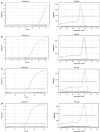Detection of Verticillium species in Swedish soils using real-time PCR
- PMID: 28741076
- PMCID: PMC5663805
- DOI: 10.1007/s00203-017-1412-z
Detection of Verticillium species in Swedish soils using real-time PCR
Abstract
Verticillium species are soilborne plant pathogens, responsible for big yield losses worldwide. Here, we report improved procedures to generate DNA from Verticillium species imbedded in farm soils. Using new genomic sequence information, primers for V. dahliae, V. albo-atrum, V. tricorpus, and V. longisporum were designed. In a survey of 429 samples from intensively farmed soil of two Swedish regions, only V. dahliae and V. longisporum were identified. A bias towards V. longisporum (40%) was seen in the south, whereas V. dahliae was more frequent in the western region (19%). Analyses of soil and leaf samples from 20 sugar beet fields, where foliar wilting had been observed, revealed V. dahliae DNA in all leaf and soil samples and V. longisporum in 18 soil samples, illustrating host choice and longevity of the V. longisporum microsclerotia. This study demonstrates the applicability of new molecular diagnostic tools that are important for growers of variable crops.
Keywords: Beta vulgaris; Brassica napus; Soilborne pathogens; Verticillium; qPCR.
Conflict of interest statement
The authors declare that they have no conflict of interest.
Figures

References
-
- Almquist C, Persson L, Olsson Å, Sundström J, Jonsson A. Disease risk assessment of sugar beet root rot using quantitative real-time PCR analysis of Aphanomyces cochioides in natural infested soil samples. Eur J Plant Pathol. 2016;145:731–742. doi: 10.1007/s10658-016-0862-5. - DOI
-
- Andersson C (2003) Detection methods of Verticillium longisporum in soil and in oilseed rape. M.Sc. Dissertation 45: ISSN 1651-5196, Swedish University of Agricultural Sciences (SLU)
-
- Chaouachi M, Alaya A, Ali IB, Ben Hafsa A, Nabi N, Berard A, Romaniuk M, Skhiri F, Said K. Development of real-time PCR method for the detection and the quantification of a new endogenous reference gene in sugar beet “Beta vulgaris L.”: GMO application. Plant Cell Rep. 2013;32:117–128. doi: 10.1007/s00299-012-1346-5. - DOI - PubMed
MeSH terms
Substances
LinkOut - more resources
Full Text Sources
Other Literature Sources

